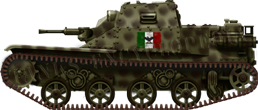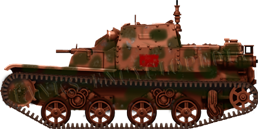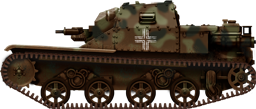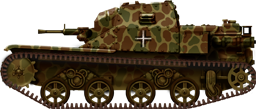The last Italian tankette
Although better designs had already been concocted, the versatile and cheap chassis of the CV-33/35 family had not exhausted all its resources yet. The L3/38 was, in 1940, the latest evolution of the L3 tankettes. According to their 1930s program of renovation and strengthening of the armored forces, a Brazilian military mission was to select the most appropriate model to be bought from Europe. The CV-38 were selected and 23 were purchased in 1938, 17 of which were armed with a 7.7 mm (0.3 in) machine gun each, three with 13.2 mm (0.52 in) Breda HMGs and three were unarmed command vehicles.4-view drawing of the CV.38.
They were designated as support machine-gun tanks (Autometralhadoras). According to other sources, 23 CV-35s were purchased for the tank school, although referred as "Auto Metralhadoras de Reconhecimento" (AMR), and divided between four platoons of five tankettes each (and three in reserve). These were equipped with twin Madsen 7 mm (0.27 in) LMGs, and another five armed with 13.2 mm (0.52 in) Breda HMGs. These were all replaced during the war with American M5 light tanks.
The Brazilian version
According to their 1930s program of renovation and strengthening of the armored forces, a Brazilian military mission was to select the most appropriate model to be bought from Europe. The CV-38 were selected and 23 were purchased in 1938, 17 of which were armed with a 7.7 mm (0.3 in) machine gun each, three with 13.2 mm (0.52 in) Breda HMGs and three were unarmed command vehicles. They were designated as support machine-gun tanks (Autometralhadoras). According to other sources, 23 CV-35s were purchased for the tank school, although referred as "Auto Metralhadoras de Reconhecimento" (AMR), and divided between four platoons of five tankettes each (and three in reserve). These were equipped with twin Madsen 7 mm (0.27 in) LMGs, and another five armed with 13.2 mm (0.52 in) Breda HMGs. These were all replaced during the war with American M5 light tanks. The Brazilian version was called "CV-33/II", as the second version of the original CV-33. The CV-35s exported to Brazil were probably called CV-33/I. Preserved CV-38, in an Italian camouflage customary of 1944 - Credits: Axistanksworldwarii.devhub.com
Preserved CV-38, in an Italian camouflage customary of 1944 - Credits: Axistanksworldwarii.devhub.com
It seems the late and limited production of the L3/38 meant they were stationed in Italy and Sicily, instead of reaching the North African units. The bulk were absorbed by territorial units stationed in Southern Italy in 1944. A few were used in the Sicilian campaign by Italian forces, most were captured and used by the Wehrmacht afterwards and re-used either by Mountain units (Bebirgsjagers), regular units of the Wehrmacht, or passed onto the Fascist "Republican Social Forces".
| L3/38 specifications | |
| Dimensions (L-W-H) | 3.17 x 1.5 x 1.3 m (10.4 x 3.8 x 4.2 ft) |
| Total weight, battle ready | 3.5 tons (7000 lbs) |
| Crew | 2 (driver, commander/machine-gunner) |
| Propulsion | Fiat 122AC/B, 6 cyl, 42/46hp |
| Speed | 45 km/h (27.9 mph) |
| Range (road) | 110 km (68 miles) |
| Armament (see notes) | Breda 7.7 mm machine-gun (0.3 in) |
| Armor | From 8 to 14 mm (0.3 to 0.55 in) |
| Total production | Around 200 |
Link: The whole series on Aviarmor.ru (in Russian)

L3/38 of the so-called "Repubblica Soziale Italiana" (Fascist "Republic of Salo"), LXXXXVII "Liguria" Army (Graziani), September 1944. This vehicle was in the Gothic line tactical reserve, facing French forces. This model was also used by the Wehrmacht.

L3/38R (radio version) used as a command tank, "Friuli" division based in Corsica, November 1942 (General Umberto Mondino). Four Italian divisions were committed to the occupation of Corsica after the German invasion of the French Vichy so-called "free zone". This was a strategical response to the Allied landings in North Africa (operation Torch).

Beute L3/38 of a Gebirgsjager unit, Albania, 1944.

Carro Veloce L3/38 in German service, Rome, 1944.

L3/38 of the so-called "Repubblica Soziale Italiana" (Fascist "Republic of Salo"), LXXXXVII "Liguria" Army (Graziani), September 1944. This vehicle was in the Gothic line tactical reserve, facing French forces. This model was also used by the Wehrmacht.

L3/38R (radio version) used as a command tank, "Friuli" division based in Corsica, November 1942 (General Umberto Mondino). Four Italian divisions were committed to the occupation of Corsica after the German invasion of the French Vichy so-called "free zone". This was a strategical response to the Allied landings in North Africa (operation Torch).

Beute L3/38 of a Gebirgsjager unit, Albania, 1944.

Carro Veloce L3/38 in German service, Rome, 1944.

WW2 Tanks




























WW2 tanks posters

All Tiger tanks liveries.

Panther liveries and variants

WW2 Armour - All tanks











Tanks aces and single tanks series

Find more there

Museums, Movies, Books & Games
The Tanks and Armor in pop culture
Tanks and armored vehicles in general are only really grasped when seen first person: The mass, the scale, it's all there. Explore also the way tanks were covered in the movie industry, in books and in video games.Movies:
Best tanks movie on warhistoryonline.com
On imdb.com
On bestsimilar.com/
miltours.com
liveabout.com/
watchmojo.com
Video Games:
pcgamesn.com
historyhit.com
levvvel.com
vg247.com/best-tank-games
mmobomb.com/
alienwarearena.com


